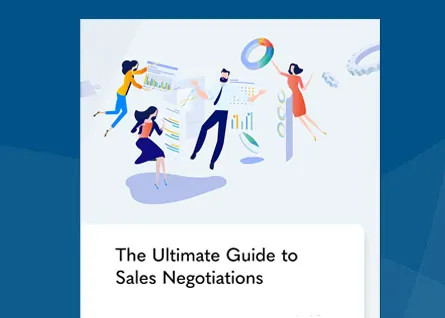How to Discuss a Price Increase With Clients

As account executives, the last thing we want to do is increase a client’s price. However, in this economic environment, increases occur daily. Of course, there are many reasons for an increase (see below), and most protect or benefit sellers. Typically, though, customers see it differently. In fact, they might feel annoyed, disappointed, or even betrayed.
While the increase itself is never personal, it can feel that way to customers. Their agreements took time. They invested in you and your organization. So, when the time comes, have a plan. With so much at stake, the right approach is key. After all, it could determine if you preserve the relationship and keep the client. Here, we will outline how account executives can minimize the impact of a price increase.
The Justification of Price Increases
Before presenting a price increase, account executives must understand the need. If you don’t understand why your organization is raising prices, you can’t effectively convey it to clients. Raising prices can offer the following benefits for your business:
- Reinvest revenue
- Improve the quality of products and services
- Redirect resources
- Increase flexibility
Assess the Market
Understanding the market can help determine when and how to raise prices. Typically, every six to nine months is a reasonable timeframe to assess conditions. Then, consider the following:
- Current demand
- Market trends
- Economic climate
Of course, economic conditions will affect demand as will new products or services. AE’s must be up on who’s ordering what and why. They must be sure they’re not offering yesterday’s widgets at today’s prices.
The current market is important, but change can happen in an instant. Before raising prices, be sure you consider trends and forecasts.
In addition, understand economic conditions. This not only affects your business. It will also affect your customers and their propensity to buy. You must know how a price increase impacts your own and your customer’s needs.
Reasons for Price Increases
Start by explaining why you are raising prices. Common reasons can include:
- Materials and production costs
- Industry trends
- Growth
As the cost of materials and/or production rises, businesses must raise prices. It’s simple economics. This is something even the most frugal customers will understand. However, it must be explained rationally and with empathy.
All businesses must keep up with their industry. If they don’t, they will quickly fall behind or, worse, disappear. A competitive analysis of industry standards can reveal deficiencies that require a price increase. There is nothing wrong with explaining this or, better, sharing specific data with the client.
All companies strive for growth. However, that doesn’t mean clients like it, especially if your growth negatively affects them. Here, then, it’s important to augment the price increase with additional benefits or services you can provide.
Pre-Price Increase Steps
In the best-case scenario, your organization prepared you in advance.. In the worst-case scenario, you were informed at this morning’s sales meeting, Regardless of lead-time, don’t be the account executive who informs a customer of a price increase out of the blue. This is the surest way to antagonize.
HubSpot lists several important tips to announce a price increase:
- Direct contact
- Lead time
- Tailored messages
- Better quality or service
- Flexible pricing
Imagine you’re a loyal customer. You’ve been reliably paying a set price for a significant amount of time. Suddenly, the price went up. If that’s not bad enough, imagine first hearing about it secondhand or in a generic mass email. Direct contact shows customers respect and lets them voice their concerns.
The more time you can give the customer, the better. This helps them to plan and manage their budgets. No matter the reason for the increase, they will appreciate your honesty and transparency. It also gives them the opportunity to buy more at the current price in advance of the increase.
All customers want to feel unique. A generic message might be expedient, but it conveys the opposite message. Whenever possible, tailor your messages to the distinct segments of your customer base. Consider their current payment plans and specific needs.
Often, sales organizations must raise prices to maintain the quality of their products or services. Most clients appreciate this. After all, quality is essential to them as well. Therefore, assure them the value they receive will continue, if not improve, with the increase. Whenever possible, reward loyal customers. Flexible prices can help, as can little favors. For example, consider delaying their increase or offering special perks or privileges.

The Approach
When having a conversation with your client, ask what they are seeing on their end. Inquire about business questions that relate to inflation and its impact. Questions you might want to consider are:
- Are supply chain issues affecting their operation?
- What’s the impact of the gasoline price?
- Has inflation changed their priorities?
Having a candid dialogue around how inflation impacts their business is a wise move. First, you are showing you care. Second, you are demonstrating business acumen. Third, you will gain insights into the clients’ plans and priorities. These help uncover potential solutions you might not have considered. Finally, it provides valuable insights that will help with future conversations with other clients and prospects. During the conversation, agree that you are seeing the same things. Once you are both in the same boat, you can share. For example, “I’ve heard management is reviewing our pricing policy. Nothing is official yet, but everything is under review.” Your client will likely want more information. Assure them you with advise when you know. As a side note, the bigger the client and increase, the more advanced notice the better.
The Price Increase Conversation
As the account executive, how you deliver the price increase to your clients will determine how they react. It must be handled in a confident and concise manner. In other words, prepare in advance.
Start with talking points or even a script. And practice your delivery before you contact the client. Consider role-play or asking another account executive to provide feedback. The more valuable the client, the more practice you need. It is nearly impossible to deliver a confident message if you are anxious, lack talking points, and have not practiced.
In your delivery, balance confidence with empathy. You do not want to come across brash, too assertive or apologetic. Never apologize for a business decision your company made. But you can acknowledge you feel uncomfortable. As much as possible, strive for empathy, likening their disappointment with your own difficulty. Here are examples:
- I feel awkward bringing this up…
- I understand…
- I know you are concerned…
The key is to be authentic and transparent, but remember emotions are contagious. Maintain a professional and confident demeanor. What you don’t want to do is open the conversation with:
“I’m sorry to be the one to tell you…”
Present the reasons why. When you use the word “because” and provide a reason, you will receive a more positive response. For example, “The reason for the price increase is because our vendors have increased our supply cost. And we strive to deliver the best quality.” In your pre-price call, you determined the effect of inflation on your client’s business. Craft messages around that dialogue. At this point, validate the reasons you provided.
After you have explained the because, thank your client for their loyalty:
“I appreciate your openness and will share your feedback with my executive team. We appreciate the opportunity to serve you.”

Be Prepared for Push Back
Even if you did everything right with the price increase conversation, some clients may push back. Some might even argue or blame you. Don’t be surprised if you hear,
“We’ve been a client for years, and this is how you reward our loyalty? Let me talk to your manager, please.”
Again, don’t panic. Prepare for pushback. In your planning, consider the negative things your clients could possibly say. Again, don’t apologize. It sends the wrong message. Also, don’t over-explain. Too much can expand the problem.
Instead, frame the conversation around the unique value you provide. Ideally, your management team has created a communication strategy, so you have a consistent message to deliver.
Delivery Channel for Price Increases
If you are a field rep visiting clients in person, in-person meetings are best to deliver price increases. If you are an inside account executive, videoconference. The third and final option is telephone. This is not a situation where you can send an email or text. Again, the more valuable the client, the more likely you will need to be in person.
The Final Word on Price Increase
The price increase conversation is one of the hardest in sales. How you handle it will impact the outcome, including relationships and future opportunities. As the account executive, you want to build value with every client conversation. Price increases are no different.
This can separate you from the competition and position yourself as a trusted advisor who adds value. As Warren Buffet said, “Price is what you pay. Value is what you get.” Focus on the value you deliver, and your clients will appreciate your approach.

Updated: 08/15/2024

- Account Planning (11)
- Awards (47)
- Client Testimonial (37)
- Personal Branding (19)
- Podcast (11)
- Research (70)
- Sales Career Development (87)
- Sales Coaching (156)
- Sales Consulting (136)
- Sales Culture (170)
- Sales Enablement (354)
- Sales Leadership (110)
- Sales Management (248)
- Sales Negotiation (16)
- Sales Prospecting (124)
- Sales Role-Playing (18)
- Sales Training (231)
- Selling Strategies (263)
- Soft Skills (70)
- Talent Management (94)
- Trusted Advisor (27)
- Virtual Selling (49)
- Webinar (9)


























